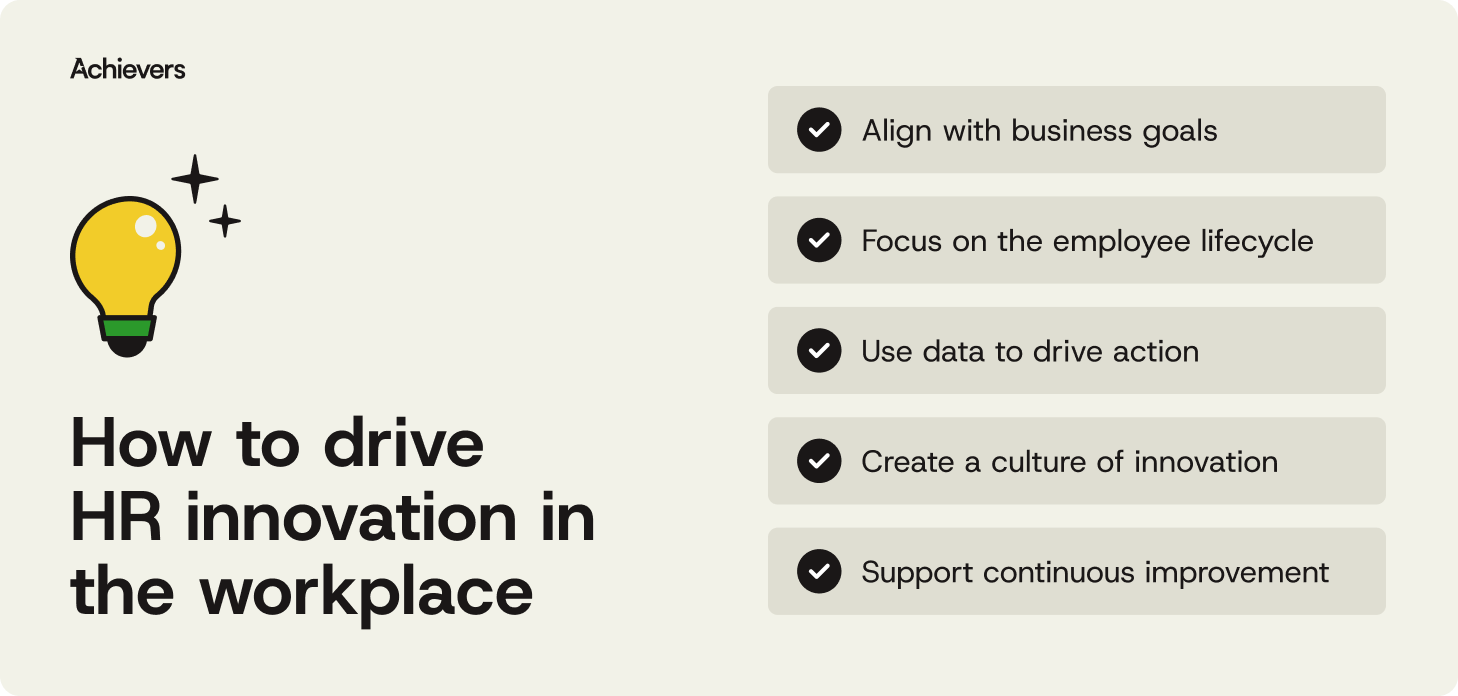Table of contents
Create a culture that means business™
Schedule a demo with an Achievers solution expert today.
HR innovation isn’t new — but the pressure to get it right is. HR has always had a seat at the table. Now it’s being handed the blueprint.
The future of work — and the expectations placed on HR teams are changing even faster. It’s no longer enough to keep things running smoothly. Leaders are looking to HR to help build what’s next: a workplace that’s agile, inclusive, and ready to grow.
That kind of transformation doesn’t come from trend-chasing or flashy tools. Real HR innovation is grounded in people — understanding what they need, recognizing what they bring, and building systems that support them at every stage.
In this blog, we’re diving into the strategies that forward-thinking HR teams are using to drive impact, build connections, and create cultures that can flex with the future.
What is HR innovation?
HR innovation is the process of transforming traditional HR practices to better support employees and meet the changing needs of work. It’s about designing smarter, more human systems — not just chasing shiny tools. Think less “process for process’ sake” and more “what actually helps people do their best work?”
When HR innovates, it uses insights, recognition, and adaptable programs to shape culture, boost performance, and keep employees feeling seen, heard, and appreciated. And the best part? Real innovation isn’t flashy. It’s the everyday moments that make work feel a little more human — and a lot more effective.
9 proven ways to drive HR innovation
True HR innovations don’t happen all at once. It shows up in the everyday moments that shape your culture. Here are nine smart, strategic ways HR teams are driving impact and building workplaces that are ready for what’s next:

1. Tie HR innovation to business goals
HR innovation doesn’t mean throwing tech at a problem. It means knowing which people-powered outcomes actually move the needle — like retention, engagement, or internal mobility — and building programs that support them.
Recognition matters here. When you reward the behaviors that drive business goals, you’re not just encouraging them — you’re making them part of how work gets done. In fact, according to the State of Recognition Report, employees who are recognized weekly are 2.6x more likely to be at their most productive.
That kind of alignment? That’s innovation that sticks.
2. Make the employee lifecycle your starting point
If your employee experience feels like a checklist, it’s time to start over. Innovation starts by rethinking the full journey — from onboarding to development to offboarding — and asking where things feel meaningful, and where they just feel…meh.
Recognition and feedback are what turn those moments into something stickier. A well-timed thank-you. A thoughtful survey that leads to change. A shoutout that makes progress visible.
When you build those signals into each stage of the lifecycle, you create momentum — and a culture people actually want to grow with.
3. Use data to drive action — not just insight
HR has no shortage of data — but collecting it isn’t the same as doing something with it. Innovation means closing the loop, fast.
If your engagement surveys or feedback tools surface a pattern, act on it. Don’t wait for quarterly reviews or exec summaries. Employees want to know their input matters — and they notice when it disappears into a black box.
The most effective HR teams use platforms that surface real-time insights and make it easy to respond with recognition, resources, or support. Because inaction? That’s louder than any feedback form.
4. Create a culture where innovation and ideas are recognized
You can’t expect bold ideas in a culture that only rewards playing it safe.
If you want employees to solve problems, test new approaches, or improve broken processes, make sure they know it won’t go unnoticed. Recognition is a powerful way to validate curiosity and initiative — even when the idea doesn’t make it past the pilot stage.
And it’s not just about the wins. It’s about showing people that effort, risk-taking, and problem-solving are valued here. That kind of message travels fast — and it builds a culture where innovation is the norm.
5. Build feedback loops for continuous improvement
Feedback should be a conversation, not a dead end.
If you’re asking for employee input, be ready to act on it — quickly and transparently. Innovation thrives when people know their voices shape real decisions, not just dashboards.
Set up easy, consistent ways for employees to share what’s working and what needs work. Then follow up. Let them know what’s changing, what’s still in progress, and what’s staying put — and why.
6. Support employee well-being as a foundation for performance
Teams can’t innovate if they’re running on empty.
Well-being plays a direct role in how people show up — not just for work, but for each other. When employees feel supported mentally, emotionally, and physically, they’re more engaged, more creative, and more likely to stick around.
Make it easy for people to take care of themselves. Celebrate healthy habits, spotlight team wins around wellness, and encourage time to reset before workplace burnout hits. When well-being is part of the conversation — and part of what gets recognized — performance follows.
7. Design recognition to support career growth and mobility
If you want employees to grow, show them it matters.
Recognition shouldn’t just reward the end result. It should highlight the stretch assignments, learning milestones, and behind-the-scenes effort that make growth possible.
When you celebrate development in real time, you reinforce a culture that values progress — not just performance. And that support matters: AWI found that 64% of employees who don’t feel their company invests in growth and development report underperforming at work.
So, if you want to raise the bar, recognize the people reaching for it.
8. Foster inclusion and psychological safety
Innovation needs disagreement — the healthy, constructive kind. But if people don’t feel safe speaking up, you’ll never hear the good stuff.
Psychological safety gives employees the confidence to challenge ideas, raise concerns, and share feedback without fear. And it’s a serious performance driver: employees with high psychological safety are half as likely to feel emotionally exhausted (17% vs. 34%) and less likely to feel ineffective at work (13% vs. 19%), according to the American Psychological Association’s Work in America™ 2024 Report.
When leaders model openness and recognize candid input, inclusion becomes more than a value — it becomes a habit.
9. Invest in the right technology
HR tech has come a long way from just keeping the lights on. Today’s platforms should do more than track hours and process forms — they should help shape culture.
A recognition platform can turn culture into something you can actually manage. Real-time, flexible recognition makes it easy to celebrate wins as they happen. Peer-to-peer visibility brings unsung contributions to light. AI-powered insights help HR spot trends early, while seamless integrations with HRIS, comms, and performance tools keep everything connected.
When you invest in tech that fuels connection, motivation, and behavior change, you move HR from back-office to business-critical. That’s the difference between running HR and reimagining it.
The benefits of HR innovations
HR innovations pay off — not just in productivity, but in how people feel about coming to work. Here’s what it unlocks:
Higher engagement and retention
From personalized experiences to meaningful recognition, innovative HR tools make it easier for people to feel appreciated — and more likely to stay.
A stronger employer brand
When your culture feels modern, inclusive, and supportive, word gets around. Innovation makes your workplace stand out for all the right reasons.
Better hiring outcomes
AI-powered recruitment tools help teams find qualified candidates faster — without the résumé version of needle-in-a-haystack searches.
Increased agility
The more adaptable your HR systems are, the faster your organization can respond to change, uncertainty, and shifting workforce needs.
The challenges of HR innovations
Of course, innovation comes with its own set of hurdles. Here’s what teams often run into:
Upfront investment
New tools and platforms can be costly at the start — but the right ones pay for themselves in saved time, higher engagement, and improved turnover.
Data security and privacy
More tech means more employee data to protect. Strong safeguards and compliance processes aren’t optional — they’re non-negotiable.
Change resistance
Not everyone loves new systems (or new anything). Clear communication, training, and recognition for early adopters help smooth the transition.
Skills gaps
Modern HR requires new skills — especially in analytics, AI, and digital program management. Ongoing development is part of the innovation journey.
Tech integration headaches
Connecting new tools to legacy systems can feel like forcing puzzle pieces that don’t quite fit. The right platform simplifies, not complicates.
Measuring impact
Some outcomes — like employer brand, psychological safety, or culture — don’t show up neatly on a dashboard. You need thoughtful metrics and the right tools to capture the whole picture.
What HR innovation looks like in practice
Not every big idea needs a budget line. Sometimes, innovation in the world of HR comes from rethinking how your existing tools, processes, and programs show up in the employee experience.
Here’s what that can look like in the flow of work:
- Use AI to streamline early-stage hiring and onboarding: Let AI handle the busy work — like resume scans and interview scheduling — so your team can focus on the human side. Pair that with onboarding that feels personal (not robotic) and early recognition that helps new hires feel like more than a calendar invite.
- Gamify learning and recognize progress: Learning doesn’t have to feel like homework. Keep it practical, self-paced, and built for real growth — then recognize the effort it takes to level up along the way.
- Build a culture of appreciation with recognition tech: A thank-you on Slack is nice. A recognition platform that connects effort to values and makes appreciation visible across the org? Way better. The right tech makes culture less of a buzzword and more of a behavior.
- Incentivize well-being initiatives: Free fruit and yoga won’t cut it. Show people that well-being matters by recognizing the moments that support it — like burnout prevention wins, wellness challenge MVPs, or actually taking that mental health day.
- Support internal mobility with recognition: People want to grow — they just need to know it’s possible. Use recognition to spotlight the messy middle of development: the stretch roles, side projects, and mentorship moments that make careers move.
Why innovation in HR is a valuable investment
Innovation isn’t just about new tools — it’s about using them to build organizational cultures where people feel seen, supported, and motivated. Recognition plays a big role in that. When it’s embedded into the flow of work, the ripple effects reach every corner of the business.
- Retain top performers by building a culture worth staying for: People stick around when they feel seen. Need proof? AWI found that 63% of employees who are meaningfully recognized at least monthly rarely think about looking for a new job. When appreciation is consistent, loyalty follows.
- Boost engagement and morale by recognizing real contributions: Appreciation that’s timely and authentic keeps motivation high and discretionary effort flowing.
- Improve efficiency by giving HR room to focus on people: Let tech handle the busy work so HR can focus on what really matters: people, culture, and strategy.
- Make smarter decisions with real-time employee feedback: Real-time feedback helps leaders see what’s working — and what needs attention — before it hits a breaking point.
- Drive business results through better alignment: When people know their growth and feedback connect to the bigger picture, they stay focused, motivated, and ready to deliver.
Power HR innovation across your organization
So how do you champion HR innovation? Where do you start?
You start with a platform that helps people feel seen, heard, and connected — every single day. One that ties recognition to real business goals and turns employee feedback into action. One that makes culture a living, breathing part of your strategy.
That’s what Achievers does best. With flexible recognition, real-time insights, and seamless integrations, our platform gives HR leaders the tools to move faster, stay aligned, and keep people at the heart of innovation.
Because when your culture works, everything else works better.



